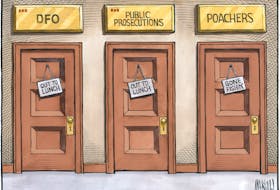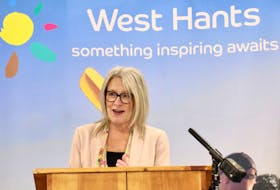For Acosia Red Elk, the hilly forests and rivers of Colchester County feel just like her home region of Pendleton in Oregon, four time zones away near the Pacific Coast.
The First Nations performer, decked out in a brightly coloured regalia, joined hundreds of other dancers at the Millbrook First Nation Competition Powwow running from Aug. 10-12.
“It has a lot of things like Oregon,” said Elk of Nova Scotia. “The culture here is a lot like ours, being that we hunt, we fish, we gather our roots and our berries and we live very close to the land.”
Elk and her fellow performers from the United States and Canada are dancing or drumming in several different categories, all vying for a cash prize coming from a money pot totaling $30,000. Performers are judged on their skills as well as the quality of their regalia.
Elk herself is a jingle dancer from Oregon's Umatilla tribe. In pre-colonial North America, jingle dancers performed a special ritual believed to help sick members of a band heal faster. The dancer would perform every day that their patient was ill, adding one ‘jingle’ to their outfit that made its distinctive noise for each day of the sickness.
However, Elk’s jingle dancing came with a twist: as someone leading a jingle dance, she required all participants to attend a yoga class, combining both First Nations and Hindu healthy living practices.
“I bring yoga into Indian country as a way to use it as a tool, to bring healing back into our bodies, physically, mentally and spiritually,” said Elk.
The message of healing was echoed by performer Carter Hatfield from Pictou Landing First Nation just outside New Glasgow.
He said that First Nations people should heal together as they overcome the legacy of colonialism. A century ago, such powwows and displays of First Nations culture were banned by the authorities.
Today, Hatfield showed off his regalia, which featured a lot of red and black colouring. He made it using cloth, metal beads, bones and feathers, similar to many others on display at the powwow.
Once regalia is put together, it is blessed with sage and tobacco near a sacred fire, in keeping with traditional First Nations religious customs.
“It makes me very proud of my people, showing that we did not let go of our culture and our ways,” said Hatfield, adding that he wanted to teach youth how to dance.
One member of the new generation is Bella Paul, a powwow performer from Cape Breton who attended with her mother Karen Bernard. Bella herself was too shy to say much, but both mother and daughter felt a First Nations revival was in the offing.
“It’s a rebirth again of our people, of our traditions, everything that encompasses who we are as a people – our identity,” said Bernard.
In keeping with the powwow tradition, the Millbrook festivities began with a grand entry of local dignitaries, holding aloft the flags of Canada, the United States, the Mi’kmaw people, and Nova Scotia, among others.
For First Nations, a powwow is not a religious ceremony, but rather a way to strengthen old friendships and make new ones, as well as showcase the community to guests.








